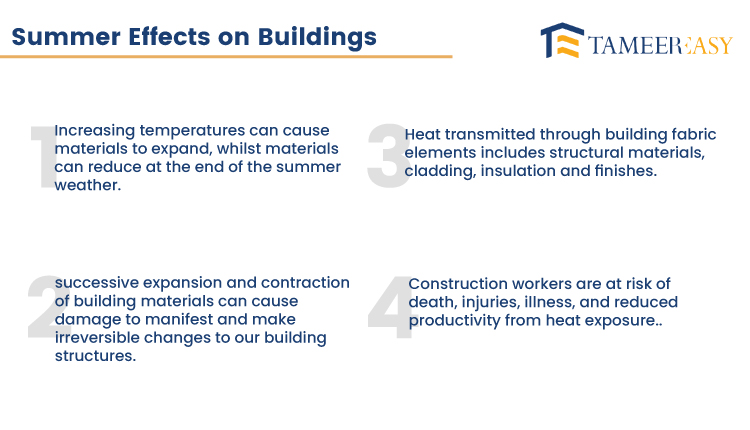Extreme weather events, such as sweltering summers, are increasing significantly worldwide as the effects of climate change continue to be felt. Building processes design and construction face significant hurdles due to these extreme temperatures.
In this post, we’ll examine how climate change affects buildings, discuss the unique problems brought on by hot summers, and examine several technologies and solutions for solving these problems.
Understanding the Effects of Hot Summers on Buildings
The many strains that hot summers place on them impact buildings’ performance, durability, and comfort. High temperatures can stress building materials, increase energy use for cooling, and present health problems.
Inadequate heat resistance in buildings can result in uncomfortable temperatures, poor interior air quality, and weakened structural integrity.
Building Design Solutions for Hot Summers
1). Passive Design Strategies
Strategies for passive design are essential for reducing the effects of hot summers. These tactics seek to maximise natural cooling, shading, and insulation from the sun. While providing adequate daylighting, building orientation, window sills design, and shading tools like overhangs and louvres can help reduce solar heat gain.
Building envelopes with efficient insulation and thermal mass can reduce heat transfer and maintain cosy interior temperatures.
2). High-performance Glazing
To beat the summer heat, choosing the right glazing system is crucial. Modern glazing techniques can dramatically minimise solar heat gain while maintaining sufficient visible light transmission. Examples include low-emissivity coatings and spectrally selective coatings.
Heat transfer from the exterior to the interior can be reduced by using double or triple windows with insulated frames to improve thermal insulation.

3). Cool Roofs
Direct sunshine can cause roof surfaces to absorb much heat, raising the temperature inside. Using cool roof techniques can solve this problem. Cool roofs reflect more solar radiation, which reduces heat absorption and lowers the cooling burden on the building.
Effective methods for achieving cooler roof surfaces include reflective coatings, highly solar-reflective materials, and vegetated roofs.
4). Natural Ventilation
Effective natural ventilation systems improve the quality of the air inside buildings and offer passive cooling in the summer. Cross-ventilation is encouraged by building designs that have movable windows, skylights and ventilation openings because it allows for the movement of fresh air and the dissipation of built-up heat.
A properly air-sealed building envelope ensures controlled airflow and minimal air leakage.
5). Green Infrastructure
Integrating green infrastructure components can reduce the heat island effect and improve thermal comfort. Examples include green roofs, vertical gardens, and shaded courtyards.
By providing shade and reducing ambient temperatures through evapotranspiration, vegetation helps to balance the urban heat island effect by generating microclimates. In particular, green roofs increase biodiversity, reduce stormwater runoff, and improve insulation.
6). Advanced HVAC Systems
To keep HVAC systems must operate efficiently to keep interior temperatures at a suitable level throughout the hot summer months. Evaporative coolers, heat recovery ventilation, and variable refrigerant flow (VRF) systems are a few examples of energy-efficient HVAC equipment that can effectively cool while using the least energy.
Smart controls and building automation systems also alter cooling requirements under real-time data and occupancy patterns to optimise energy usage.
Conclusion
It is critical to address the issues that hot summers present for building design as they grow more frequent and intense due to climate change. Buildings can better survive the heat, use less energy, and maintain occupant comfort using passive design principles, high-performance glazing, cool roofs, natural ventilation, green infrastructure, and modern HVAC systems.
Adopting these novel strategies would not only aid in overcoming the difficulties presented by hot summers. Still, it will also assist in creating a built environment that is more robust and sustainable.








